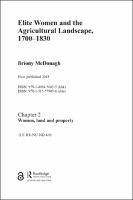Chapter 2 Women, land and property
Proposal review
| dc.contributor.author | McDonagh, Briony | |
| dc.date.accessioned | 2019-10-17 13:55:51 | |
| dc.date.accessioned | 2020-04-01T10:19:29Z | |
| dc.date.available | 2020-04-01T10:19:29Z | |
| dc.date.issued | 2018 | |
| dc.identifier | 1005051 | |
| dc.identifier | OCN: 1135845203 | en_US |
| dc.identifier.uri | http://library.oapen.org/handle/20.500.12657/25046 | |
| dc.description.abstract | This chapter explores the relations between women, land, property and the law. The first part of the chapter outlines single, widowed and married women’s legal position as property owners, paying particular attention to the doctrines of primogeniture and coverture and their impact on women’s property rights. It explores the circumstances by which women most commonly became landowners, outlining the four main routes to landownership for women, as well as the practices by which married women were sometimes able to circumvent the restrictions of coverture. As a corollary to this, it also explores the impact of various changes to the early modern legal system – including the shift from dower to jointure arrangements, the emergence of strict settlement and the declining power of the ecclesiastical courts – on women’s property rights. The second half of the chapter sets out to assess the significance of women as a class of landowners in Georgian England, quantifying the scale of women’s landholding in the eighteenth and early nineteenth centuries using a large sample of data drawn from the parliamentary enclosure awards. In doing so, it responds to considerable uncertainty about the scale of women’s property ownership. Little quantitative information is available on the proportion of land owned by women, although a handful of studies have used rentals and leases to examine female landholding – as opposed to landownership – within small groups of manors. The results of the sampled enclosure awards are presented below, comparisons between this data and the earlier, smaller studies explored, and the new data used to throw light on four key issues: the legal and marital status of female landowners, the scale of individual female landowners’ holdings, the geography of female landownership and the thorny issue of change over time. | |
| dc.language | English | |
| dc.relation.ispartofseries | Studies in Historical Geography | |
| dc.subject.classification | thema EDItEUR::N History and Archaeology | en_US |
| dc.subject.classification | thema EDItEUR::3 Time period qualifiers::3M c 1500 onwards to present day | en_US |
| dc.subject.other | women | |
| dc.subject.other | land | |
| dc.subject.other | property | |
| dc.subject.other | law | |
| dc.title | Chapter 2 Women, land and property | |
| dc.type | chapter | |
| oapen.relation.isPublishedBy | 7b3c7b10-5b1e-40b3-860e-c6dd5197f0bb | |
| oapen.relation.isPartOfBook | 455b5178-c7be-43a7-bca3-209c77b4fdea | |
| oapen.relation.isbn | 9781315579078 | |
| oapen.imprint | Routledge | |
| oapen.pages | 25 | |
| oapen.remark.public | 3-8-2020 - No DOI registered in CrossRef for ISBN 9781409456025 | |
| oapen.identifier.ocn | 1135845203 | |
| peerreview.anonymity | Single-anonymised | |
| peerreview.id | bc80075c-96cc-4740-a9f3-a234bc2598f1 | |
| peerreview.open.review | No | |
| peerreview.publish.responsibility | Publisher | |
| peerreview.review.stage | Pre-publication | |
| peerreview.review.type | Proposal | |
| peerreview.reviewer.type | Internal editor | |
| peerreview.reviewer.type | External peer reviewer | |
| peerreview.title | Proposal review | |
| oapen.review.comments | Taylor & Francis open access titles are reviewed as a minimum at proposal stage by at least two external peer reviewers and an internal editor (additional reviews may be sought and additional content reviewed as required). |

